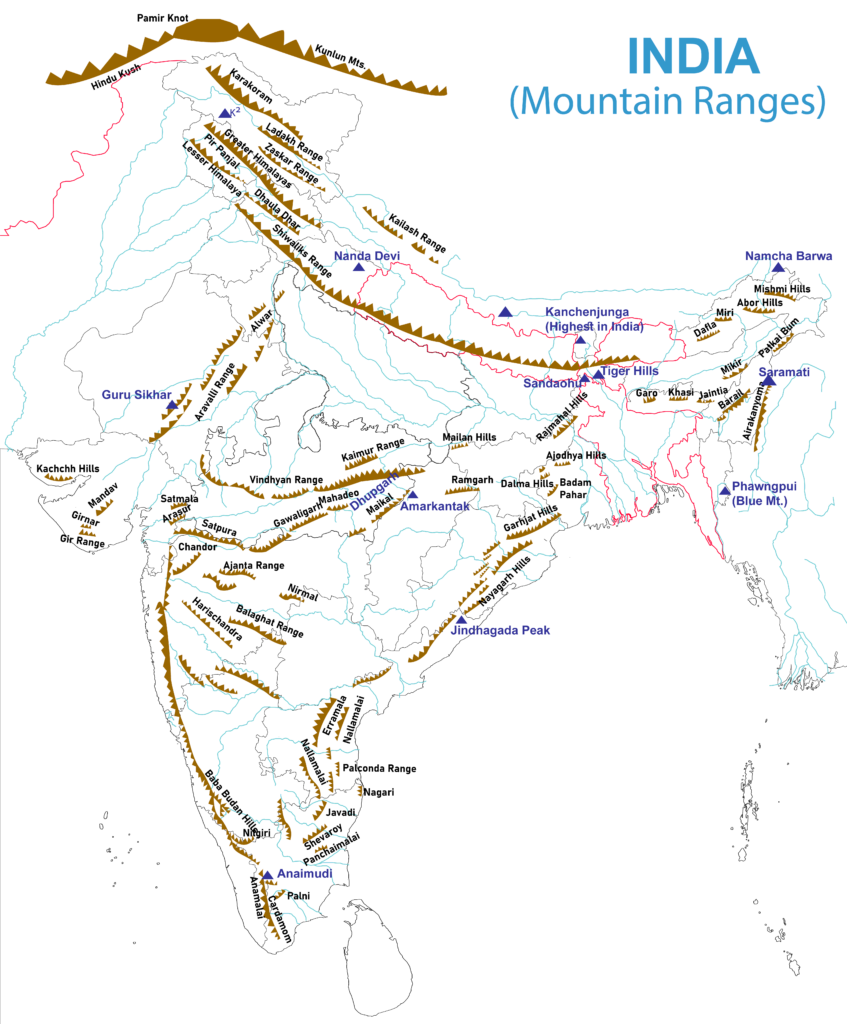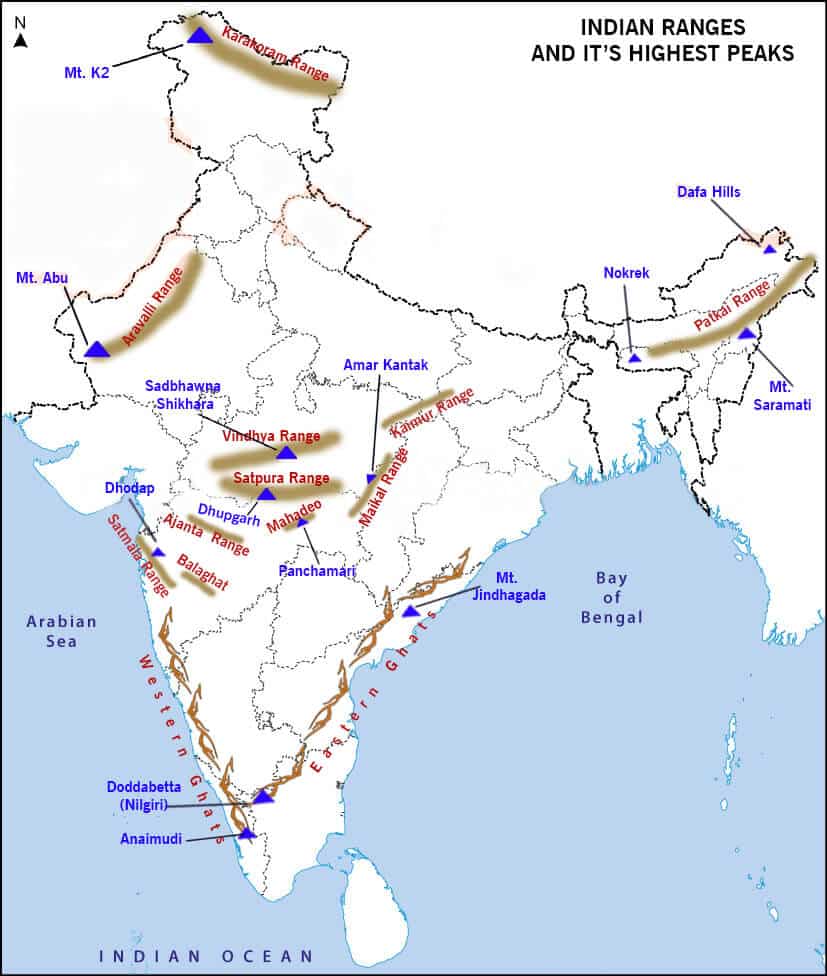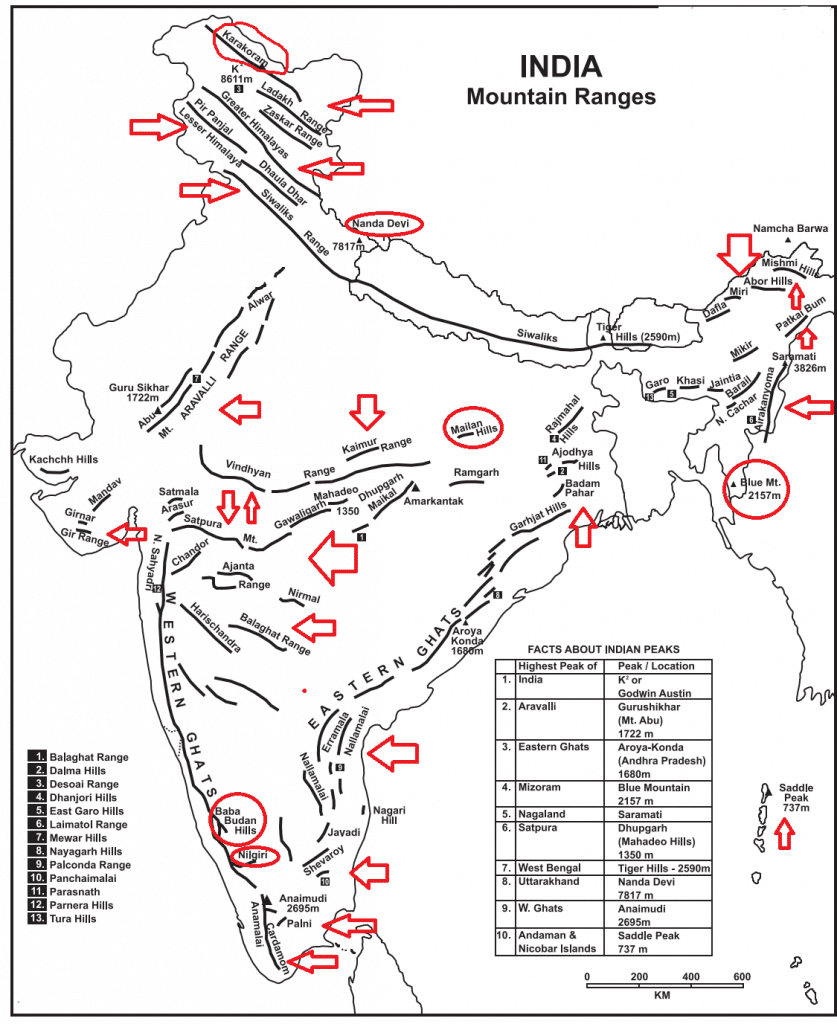
Important Hill Ranges of India
- Aravalli hills
- Vindhyan range
- Satpura range
- Western Ghat
- Eastern Ghat

Aravalli hills
- They originate in Gujarat (at Palanpur) and extend till Haryana. They terminate in the Delhi ridge.
- They have a maximum extent of 800 km
- They are old fold mountain ranges, one of the oldest tectonic mountains in the world.
- Rocks that make up the Aravallis are more than 2 billion years old.
- Unlike other fold mountains, Aravallis have an average elevation in the range of 400-600m only. This is because throughout their geological history they were subjected to the processes of weathering and erosion.
- Only a few peaks reach an elevation of above 1000m. These include – Mt. Gurushikhar (1722m, the highest point of Aravallis), Mt.Abu (1158m, it’s part of a plateau).
- Geologically, they are mainly made up of Dharwar igneous and metamorphic rocks.
- They contain the largest marble deposits in India.
- Rivers Banas, Luni, Sabarmati are born in Aravallis. Banas is a tributary of Chambal. Luni is an ephemeral river that terminates in the Rann of Kutch.
- They contain several passes that cut through them, especially between Udaipur and Ajmer like Piplighat, Dewair, Desuri, etc.
- They also contain several lakes such as Lake Sambhar (largest inland saline water body in India), Lake Dhebar (south of Aravallis), Lake Jaisamand (in the Jaisamand wildlife sanctuary), etc.
Vindhyan range
- These are non-tectonic mountains, they were formed not because of plate collision but because of the downward faulting of the Narmada Rift Valley (NRV) to their south.
- They extend for 1200km from Bharuch in Gujarat to Sasaram in Bihar.
- Geologically, they are younger than Aravallis and Satpura hills.
- Their average height is in the range of 300-650m.
- They are made up of older Proterozoic rocks. They are cut across by Kimberlite piles (diamond deposits)
- They are known by local names such as Panna, Kaimur, Rewa, etc.
- They rise from the NRV in the form of steep, sharp slopes called the escarpments. These escarpments are well developed in Kaimur and Panna regions.
Satpura range
- Satpura range is a combination of Satpura, Mahadeo, and Maikala hills.
- Satpura hills are tectonic mountains, formed about 1.6 billion years ago, as a result of folding and structural uplift. They are a Horst landform.
- They run for a distance of about 900km.
- Mahadeo hills lie to the east of Satpura hills. Pachmarhi is the highest point of the Satpura range. Dhupgarh (1350m) is the highest peak of Pachmarhi.
- Maikala hills lie to the east of Mahadeo hills. Amarkantak plateau is a part of the Maikala hills. It is about 1127m.
- The plateau has the drainage systems of Narmada and Son, hence it has drainage into the Bay of Bengal as well as the Arabian sea.
- These are mostly situated in the States of Madhya Pradesh and Chhattisgarh.
- These hills are rich in bauxite, due to the presence of Gondwana rocks.
- Dhuandhar waterfalls over the Narmada is situated in MP.
| Maikal Range | Eastern part of the Satpuras range (MP) |
| Kaimur Range | Eastern portion of the Vindhya Range in MP, UP & Bihar, Parallel to river son |
| Mahadeo Range | forms the central part of the Satpura Range, located in MP Highest peak: Dhoopgarh |
| Ajanta Range | Maharashtra, south of river Tapi, sheltering caves of world famous paintings of Gupta period |
| Rajmahal Hills | In Jharkhand made up of lava basaltic rocks Point of Ganges bifurcation |
| Garo Khasi Jaintia Hills | Continuous mountain range in Meghalaya |
| Mikir Hills | a group of hills located to the south of the Kaziranga National Park (Assam) a part of the Karbi Anglong Plateau |
| Abor Hills | Hills of Arunachal Pradesh, near the border with China, bordered by Mishmi and Miri Hills drained by Dibang River, a tributary of the Brahmaputra |
| Mishmi Hills | in Arunachal Pradesh with its northern & eastern parts touching China Situated at the junction of Northeastern Himalaya and Indo-Burma ranges |
| Patkai Range | Also known as Purvanchal Range, consist of three major hills The Patkai-Bum, the Garo-Khasi-Jaintia, and Lushai Hills situated on India’s north-eastern border with Burma |
| Koubru Hill | also known as Mount Koupalu is one of the highest mountains in Manipur, and the abode of the god Lainingthou Koubru and the goddess Kounu in Manipuri mythology. |
| Mizo Hills (Lushai Hills) | part of the Patkai range in Mizoram and partially in Tripura |
| Dalma Hills | Located in Jamshedpur, famous for Dalma national park & minerals like iron ore & manganese. |
| Dhanjori Hills | Jharkhand |
| Girnar Hills | Gujrat |
| Baba Budan Giri | Karnataka |
| Harishchandra | At Pune, acts as a water divide bw Godavari & Krishna Hills made up of lava |
| Balaghat range | Bw MP & Maharashtra, famous for manganese deposits |
| Chilpi series | MP |
| Talcher series | Odisha, rich in bituminous coal |
| Champion series | Karnataka, Dharawar period, rich in gold (contains kolar mines) |
| Nilgiri Hills | Referred as Blue mountains, a range of mountains in the westernmost part of Tamil Nadu at the junction of Karnataka and Kerala Hills are separated from the Karnataka plateau to the north by the Moyar River and from the Anaimalai Hills & Palni Hills to the south by the Palghat Gap |
| Palani Hills | The eastward extension of the Western Ghats ranges adjoin the high Anamalai range on the west, and extend east into the plains of Tamil Nadu |
| Anamalai Hills | Also known as Elephant Hill, a range of mountains in the Western Ghats in Tamil Nadu and Kerala with the highest peak Anamudi |
| Cardmom Hills | Part of the southern Western Ghats located in southeast Kerala and southwest Tamil Nadu |
| Pachamalai Hills | also known as the Pachais, The Eastern Ghats in Tamil Nadu |
| Parasnath Hill | Parasnath is a mountain peak in the Parasnath Range. It is located towards the eastern end of the Chota Nagpur Plateau in the Giridih district of Jharkhand. |


Dear Sir agr aapke ye topic wise notes cover kre to Enough h kya Optional ke liye ??
Dear Mohit, You have to read the basics of NCERT, GC Leong, and other standard books. but If you have less time then you can read our articles, and do value addition from current affairs/magazine.
good content very beneficial
Dhupgarh and panchamari hills are marked incorrectly
eastern ghat highest peak is “Jindhagada Peak(1690 mt) not arma konda
Arma konda is the highest peak on R Godavari catchment area
Excellent